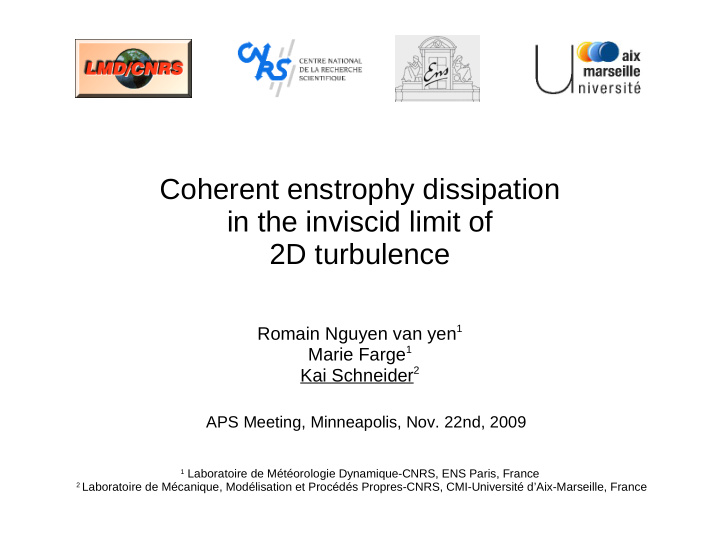



Coherent enstrophy dissipation in the inviscid limit of 2D turbulence Romain Nguyen van yen 1 Marie Farge 1 Kai Schneider 2 APS Meeting, Minneapolis, Nov. 22nd, 2009 1 Laboratoire de Météorologie Dynamique-CNRS, ENS Paris, France 2 Laboratoire de Mécanique, Modélisation et Procédés Propres-CNRS, CMI-Université d’Aix-Marseille, France
Introduction
How to decompose turbulent fluctuations? ‘In 1938 Tollmien and Prandtl suggested that turbulent fluctuations might consist of two components, a diffusive and a non-diffusive. Their ideas that fluctuations include both random and non random elements are correct, but as yet there is no known procedure for separating them.’ Hugh Dryden, Adv. Appl. Mech., 1, 1948 turbulent fluctuations = non random + random = coherent structures + incoherent noise turbulent dynamics = chaotic non diffusive + stochastic diffusive = inviscid nonlinear dynamics + turbulent dissipation Coherent Vorticity Simulation (CVS) Farge, Schneider, Kevlahan, Farge, Pellegrino, Schneider Farge et al., Fluid Dyn. Res., 10 , Phys. Fluids, 11 (8), 1999 Phys. Rev, Lett. 87 (5), 2001 229, 1992
Definition of coherent enstrophy
1D Wavelet bases ● Orthogonal wavelet bases on the real line are obtained by dilating and translating a single, well chosen oscillating function. ● They have good locality properties both in scale and space . The « coiflet 12 » wavelets and their corresponding energy spectra. the construction can be generalized to any dimension using the multiresolution formalism . S. Mallat, A wavelet tour of signal processing , Academic Press (1999)
2D Wavelet bases k y k x
Scalewise and directionwise extraction As a first guess, we make the hypothesis that the incoherent part is an additive Gaussian noise . Gaussian contributions will correspond to the smallest wavelet coefficients at their respective scale. Hence we can separate them by thresholding : → incoherent μ is the direction j is the scale i is the position → coherent The scalewise and directionwise thresholds are determined from the field itself using a fixed-point iterative procedure (*). (*) Azzalini et al., ACHA 18 (2004)
Results
t=4 10 20 40 80 120 N=512 2 Re=10 3 N=1024 2 Re=2.10 4 N=2048 2 Re=10 5 N=4096 2 Re=3.10 5 N=8192 2 Re=10 6
t = 40 Coherent Vorticity Extraction N = 512 N = 1024 N = 2048 N = 4096 N = 8192 Re = 4 10 3 Re = 1.5 10 4 Re = 6 10 4 Re = 2.5 10 5 Re = 10 6 Total 97% N 98% N 98% N 98% N 98% N 0.4% Z 2% Z 4% Z 8% Z 12% Z Incoherent 3% N 2% N 2% N 2% N 2% N 99.6% Z 98% Z 96% Z 92% Z 88% Z Coherent
t = 40 Coherent Vorticity Extraction
Scalewise statistics: Extraction Results vorticity PDF enstrophy spectra k -1 wavenumber ● the incoherent part has a k -1 inertial range spectrum
Scalewise statistics: Extraction Results vorticity PDF enstrophy spectra k -1 wavenumber ● the incoherent part has a k -1 inertial range spectrum ● the coherent part dominates in the dissipative range (!!)
Scalewise statistics: Extraction Results vorticity PDF enstrophy spectra k -1 wavenumber ● the incoherent part is ● the incoherent part has a k -1 close to marginally Gaussian inertial range spectrum ● the coherent part dominates in the dissipative range (!!)
Dissipation of coherent enstrophy enstrophy at t = 50 normalized by initial enstrophy initial enstrophy enstrophy that has been dissipated between t = 0 and t = 50 total enstrophy does not dissipate in the inviscid limit (*) (*) Dmitruk & Montgomery 2005, Tran & Dritschel 2006
Dissipation of coherent enstrophy enstrophy at t = 50 normalized by initial enstrophy initial enstrophy coherent enstrophy that has been dissipated between t = 0 and t = 50 total enstrophy does not dissipate in the inviscid limit ...but coherent enstrophy dissipates in the inviscid limit
Dissipation of coherent enstrophy enstrophy at t = 50 normalized by initial enstrophy total enstrophy does not dissipate in the inviscid limit ...but coherent enstrophy dissipates in the inviscid limit due to the production of incoherent enstrophy
Conclusion ● Coherent enstrophy was defined using scalewise statistics of the vorticity field that could be obtained thanks to a wavelet transform. ● The Navier-Stokes equations at increasingly high Reynolds numbers were solved using a classical pseudo-spectral method. ● The analysis of the numerical solutions shows that coherent enstrophy is dissipated in the inviscid limit , even though total enstrophy is conserved. ● The remainder, incoherent enstrophy , gets spread between wavelet coefficients that behave like a correlated Gaussian process with a spectral slope -1, like the total vorticity field. ● We conjecture that only the coherent coefficients have to be solved for deterministically using Coherent Vortex Simulation , while the incoherent ones could be modelled by a random process. More references: http://wavelets.ens.fr Numerical tools (incl. parallel wavelet transform): http://justpmf.com/romain/kicksey_winsey
Recommend
More recommend